16 3.4 Major Book Formats
Learning Objectives
- Determine the role of hardcover books in the publishing industry.
- Identify the differences in the two major formats of paperback books.
- Recognize the changes that e-books bring to the publishing industry.
From ancient Egyptian papyrus scrolls to scrollable 21st-century e-books, a book can come in many different formats. However, in some ways, it seems like the more things change, the more they stay the same. In the same way that early printed books were painstakingly illuminated to look more like medieval books, today’s e-books use e-paper technology to mimic the look of a printed page. Even the hardcover books we’re familiar with today are direct descendants of the ancient codex.
Hardcover
While the first codices enclosed bound papers between wooden covers (the word codex means block of wood in Latin), contemporary hardcover book covers are usually made of cardboard sheathed in cloth, paper, or leather. The printed pages of the book are either sewn or glued to the cover. Until the early 1800s, most books were sold unbound. A buyer would purchase a sheath of printed papers that would be bound either by the bookseller or by a commissioned bindery. British publisher William Pickering is considered the first publisher to issue books in uniform cloth bindings in 1820. About a decade later, dust jackets, the detachable outer covers that sheathe most hardback books today, arrived on the scene. Dust jackets were initially meant only as a protective covering for the binding, but soon they became a place where designers could create a colorful and distinctive cover for a book.
The durability of hardcover books makes them attractive to both authors and book purchasers. However, the competitive economics of today’s publishing industry means that some books are never issued in hardcover. Because hardcover books are more expensive to produce and almost always cost more than their paperback equivalents, publishers tend to reserve the format for books that they expect will sell well.
Based on projected sales, publishers must decide how big of a print run to order for a new hardcover book. A book’s print run refers to all the copies made in one setup of the printing apparatus. A failed book may only have one, while a successful book may have 50 or more printings. Figuring out how many copies of a book to print is an inexact science, as publishers must essentially guess how well a book will sell. There is no standard size for a print run. The U.K. edition of the first Harry Potter book had an initial print run of only 500 copies; the U.S. print run of the seventh and final book in the series was a record-breaking 12 million. When an initial print run is sold out, the book is either reprinted (these copies are considered a second printing) or is considered out of print. The contemporary publishing industry will often issue a first-run hardcover printing, followed by subsequent paperback editions.
Paperback
Inexpensive paper-bound books have been around for centuries in formats like the chapbook, the British penny dreadful, and the American dime novel. However, the hardcover book, whether as an ancient codex or its contemporary equivalent, was the dominant format in the book world for thousands of years. The introduction of a new format in the 1930s, the paperback, was considered revolutionary. The so-called paperback revolution began during the Great Depression, when paperbacks were marketed as inexpensive alternatives to hardcover editions. Penguin Books, Ltd., the first majorly successful paperback publishing company, kept prices low by ordering large print runs and selling books in nontraditional retailers, such as Woolworth’s drugstores. Penguin also broke the traditional paperback mold by avoiding pulp fiction entertainment novels and instead printing books that were both cheap and intellectually stimulating. Donald Porter Geddes, the editor of Pocket Books, the first paperback publishing house in the United States, spelled out this new approach to bookselling in 1944: “The best books apparently have the greatest appeal to the greatest number of people…the larger American public need no longer suffer from the delusion that it is intellectually inferior, or, from a literary point of view, lacking in any aspect in good taste, judgment, and appetite (Ogle, 1960).” By 1960, when paperback books first outsold hardcovers, these early paperback innovators were proved right.
While paperback publishing first issued only reprints of books that had already been issued in hardcover, paperback originals, books that had their initial print run as a paperback edition, emerged in the 1950s. Paperback originals were another step in helping to remove the stigma from the paperback book. In 1999, Jhumpa Lahiri’s The Interpreter of Maladies was the first paperback original to win the Pulitzer Prize for fiction.
Today’s books published in paperback are traditionally divided into two broad categories: mass-market paperbacks and trade paperbacks. Mass-market paperbacks are small, inexpensive editions that are sometimes issued after a hardcover edition, although many genre novels are printed only in mass-market paperback editions. Trade paperbacks are larger and generally of better quality. They’re often printed on higher-quality paper (sometimes acid-free paper). If the trade paperback follows a hardcover release, the paperback will be the same size as the hardcover and will have the same pagination and page layout as the hardcover edition.
Traditionally, hardcover books have been seen as more prestigious than paperbacks, though that stereotype may be beginning to change. In recent years, some publishers of literary fiction were seeing 50 to 75 percent of the hardcover books they shipped to bookstores returned to them unsold. As a response, certain publishers opted to release books with uncertain sales potential as trade paperbacks, bypassing the hardcover format entirely. “Getting somebody to spend $22 on a book by an author who they’ve never heard of is hard, but getting them to spend $13.95 on a paperback is much easier,” Random House’s Jane von Mehren told The New York Times in 2006 (Wyatt, 2006). Some publishers are concerned that book reviewers don’t take trade paperback editions as seriously, but that too may be slowly changing. Another publishing strategy is to release hardcover and trade paperback editions simultaneously rather than delaying the paperback edition for several months (or even years, in the case of exceptionally popular books). Such a technique is intended to drive up sales, taking advantage of initial publicity to capture readers who may be unwilling to pay the full hardcover price for a book.
Whatever the concerns that publishers may have about issuing paperbacks, the format is still dominant in the U.S. publishing industry. According to the American Association of Publishers (AAP), 35 percent of the books sold in 2009 were trade paperbacks; 35 percent hardcovers; 21 percent mass market paperbacks; 2 percent audio books; 2 percent e-books; and 5 percent “other (Eco-Libris).”
E-Books
The hardcover book’s expensive, durable binding seemed to say that it was an object intended for posterity. If paperback books disrupted the traditional concept of books by making them cheaper and more portable, then the e-book is poised to cause an even greater change in how readers interact with a text. E-books, also known as electronic or digital books, are the digital media equivalent of printed books. That is, they are books read on the screen of an electronic device, whether a cell phone, personal computer, or dedicated e-book reader.
E-books differ from their print equivalents in many significant ways. For one, there’s no physical production cost, which means that e-books are generally less expensive than traditional books. There’s also no cost to store or transport e-books. Because an e-book’s publisher doesn’t need to order a set print run, a text issued as an e-book doesn’t ever have to go out of print. E-books also appeal to readers who want instant gratification. Instead of having to travel to a brick-and-mortar bookstore or wait for a delivery, a reader can download an e-book in a matter of minutes.
Early e-books were mostly technical manuals or digitized versions of works in the public domain. As the Internet took off and as electronic devices became increasingly mobile, book publishers began to issue digital editions of their works. In the first decade of the 21st century, various companies began issuing software and hardware platforms for electronic books, each competing for dominance in this emerging market.
Although e-books make up only a small percentage of total book sales, that number is growing. Dan Brown’s The Lost Symbol, the follow up to his massively popular novel The Da Vinci Code, sold more copies as a Kindle e-book than as a hardcover in the first few days after its September 2009 release. However, e-book successes have led to a threat that faces many kinds of digital content: online piracy. Only a few days after its initial release, Brown’s novel had been illegally downloaded more than 100,000 times. Some authors and publishers are concerned that Internet users expect free content and will find a way around spending money on e-books. American novelist Sherman Alexie recently voiced some of these anxieties, “With the open-source culture on the Internet, the idea of ownership—of artistic ownership—goes away (Frisch, 2010).” Other prominent authors have reacted to the e-book in various ways. In 2000, Stephen King published his novella Riding the Bullet as a digital file that could only be read on a computer; in contrast, J. K. Rowling has stated that the Harry Potter novels won’t ever be released as e-books (McHugh, 2005). However, piracy has struck Rowling’s novels as well. Every Harry Potter novel is available in pirated form, either as a scanned copy or one that was manually typed out by fans.
Another concern with e-books is the possibility of digital decay. All an e-book is, after all, is a collection of data saved to a disk. It turns out that digital formats tend to decay much faster than their physical counterparts (Bollacker, 2010). The swift turnover of digital devices is another concern; the possibility exists that a book bought on a Kindle device in 2010 will be not be compatible with an equivalent device in 2035 or even 2015.
E-book sales still make up a small part of the overall book market, 3 to 5 percent by most estimates, but their sales increased by 177 percent in 2009. The New Yorker cites a projection that e-books will someday account for between 25 and 50 percent of all book sales (Auletta, 2010). And with newer models of e-book readers, such as the iPad, boasting full color screens and the ability to embed web links and video in a book’s text, e-books may fundamentally reshape how people read in the future.
As 2021 draws to a close, we can all probably agree it went by about twice as fast as 2020. Even at that dizzying speed, we have some interesting learnings from our Scribd community about all things books in 2021. From trends around mysteries, thrillers, and crimes to those focused on self-improvement and personal growth, we’re discovering interesting details about reading trends and popular books each month, and now we turn to the full year.
Here, we dive into social media’s impact on book trends and why the book-to-screen movement is on fire. Plus, we take a look at where people are reading most and what they’re reading in 2021.
Social media is changing the world; so it makes sense that it would play a role in the ways many of us read. With TikTok, we saw an uptick of popular books and genres from young adult to classics.

Generally, quarter-over-quarter growth held steady at 50% for
#BookTok-promoted books throughout 2021. What’s most notable is following an -18% decline in reading before any BookTok attention, books highlighted in TikTok saw an average 75% spike after promotion on that platform. Notably
It Ends With Us enjoyed a 70% jump thanks to BookTok, going from -17% before promotion to 53% to 73% to 141% quarter-over-quarter, and
Song of Achilles jumped 68% from 1% to 69% then continued to grow at 59% and 31%.
Seven Husbands of Evelyn Hugo was especially interesting because it went from a -24% decline in Q3 2020 to 48% growth in Q4 — that’s a 72% jump in just one quarter — then it held relatively steady growth at 46% in Q1 2021 and 41% in Q2 .
Movies and streaming services like Netflix pretty much saved us during the pandemic. Binge-watching definitely became a thing, and
binge-reading wasn’t far behind. In fact, one of our top performing Editorial lists has always been
Book-to-Screen Adaptations, and we saw a rise in book popularity in-line with the launch of a Netflix series or movie. For example,
Bridgerton,
Shadow and Bone,
The Queen’s Gambit, and
Nomadland were all books on Scribd that signaled correlation with the movie version.
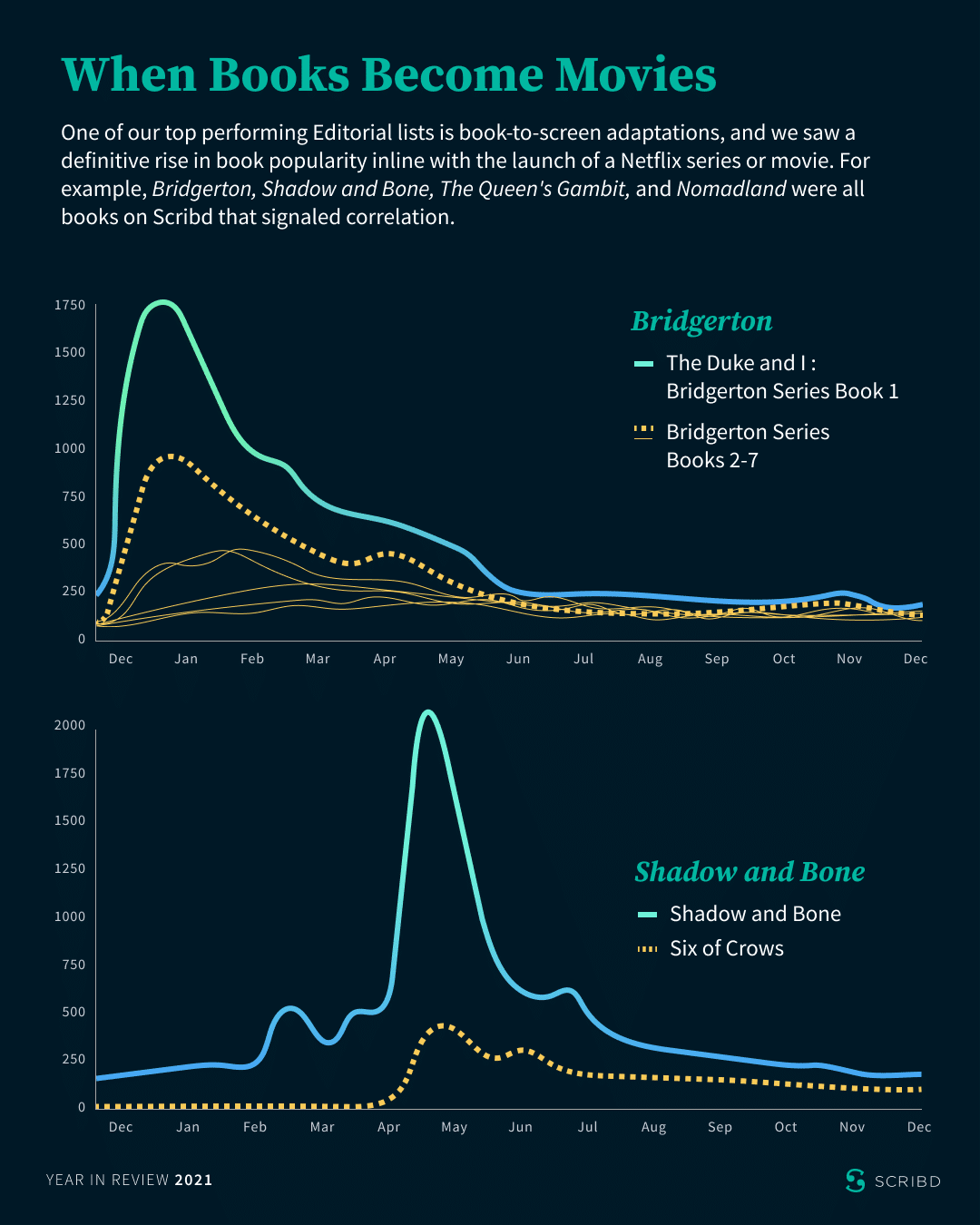
For series like Bridgerton and Shadow and Bone, we saw sharp spikes around release date (December 25, 2020 and April 23, 2021, respectively) along with a sharp decline for the first book, followed by spikes at a slightly lower but still high level for the remaining books in the series.
Specifically, read starts for the first book in the Bridgerton series, The Duke and I, increased by an impressive 1,672.9%. With these growth rates, it points to the relative obscurity of the book before Netflix spotlighted it. Shadow and Bone, which was more established when Netflix debuted the series, still enjoyed a lift with read starts increasing by 267%. Romance and young adult genres tend to be quick reads, so it makes sense that readers would consume these books swiftly and frequently.
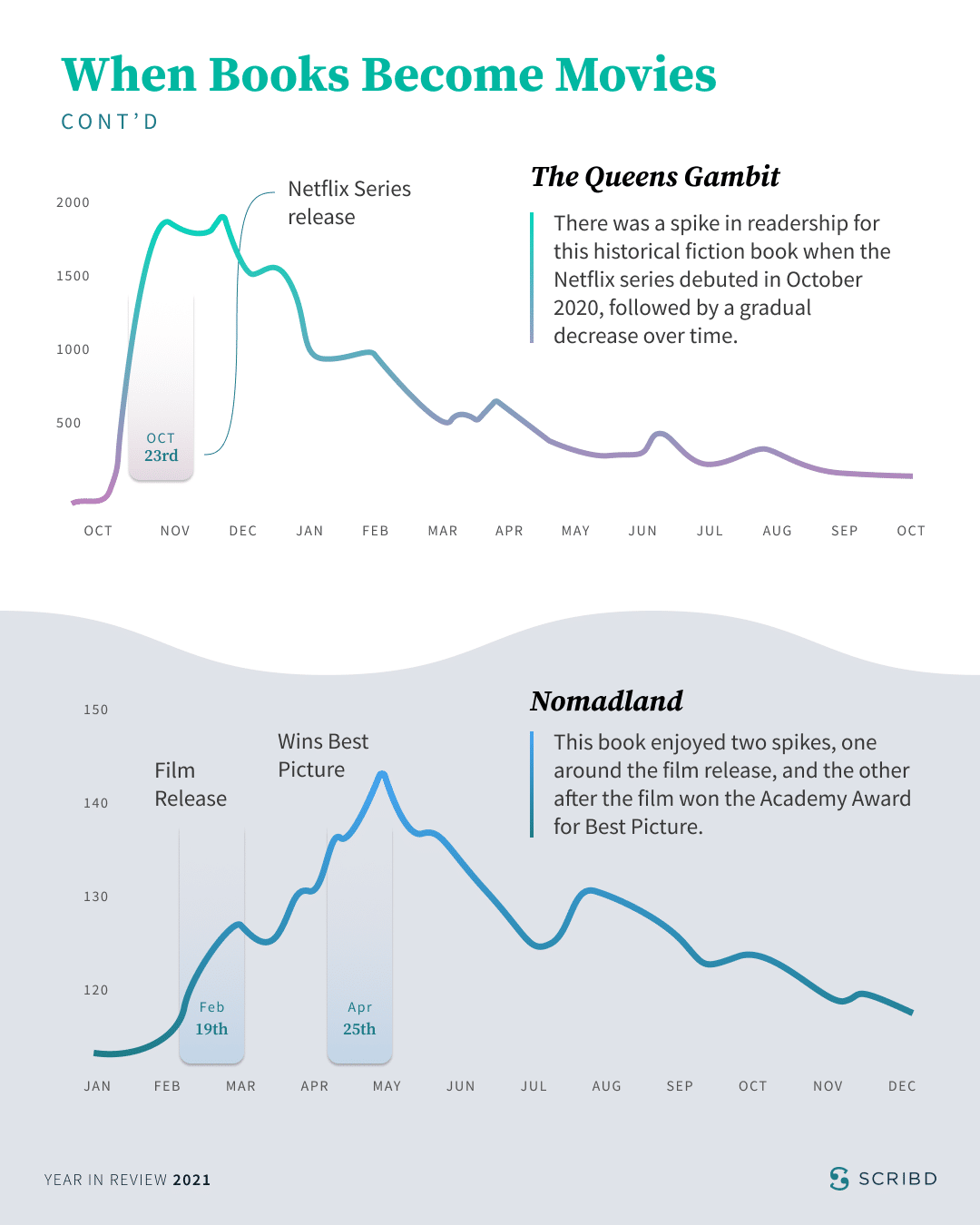
Upon looking at what users were searching, we learned about amigurumi, which is the art of crocheting small, stuffed animals. This seemingly esoteric Japanese crafting trend skyrocketed 440% to the top search terms in 2021 after being buried deep in the search results back in 2019.
Similarly, we’ve seen audiobooks take off in recent years as it provides a convenient way to multitask and still fit in a great read. Our search results show audiobooks weren’t on the search radar in 2019 but rocketed to the top in 2021. In the past year alone, from 2020 to 2021, searches that included the term “audiobook” grew by 22%. While that’s impressive, searches from 2019 compared to 2021 grew by a whopping 515%.
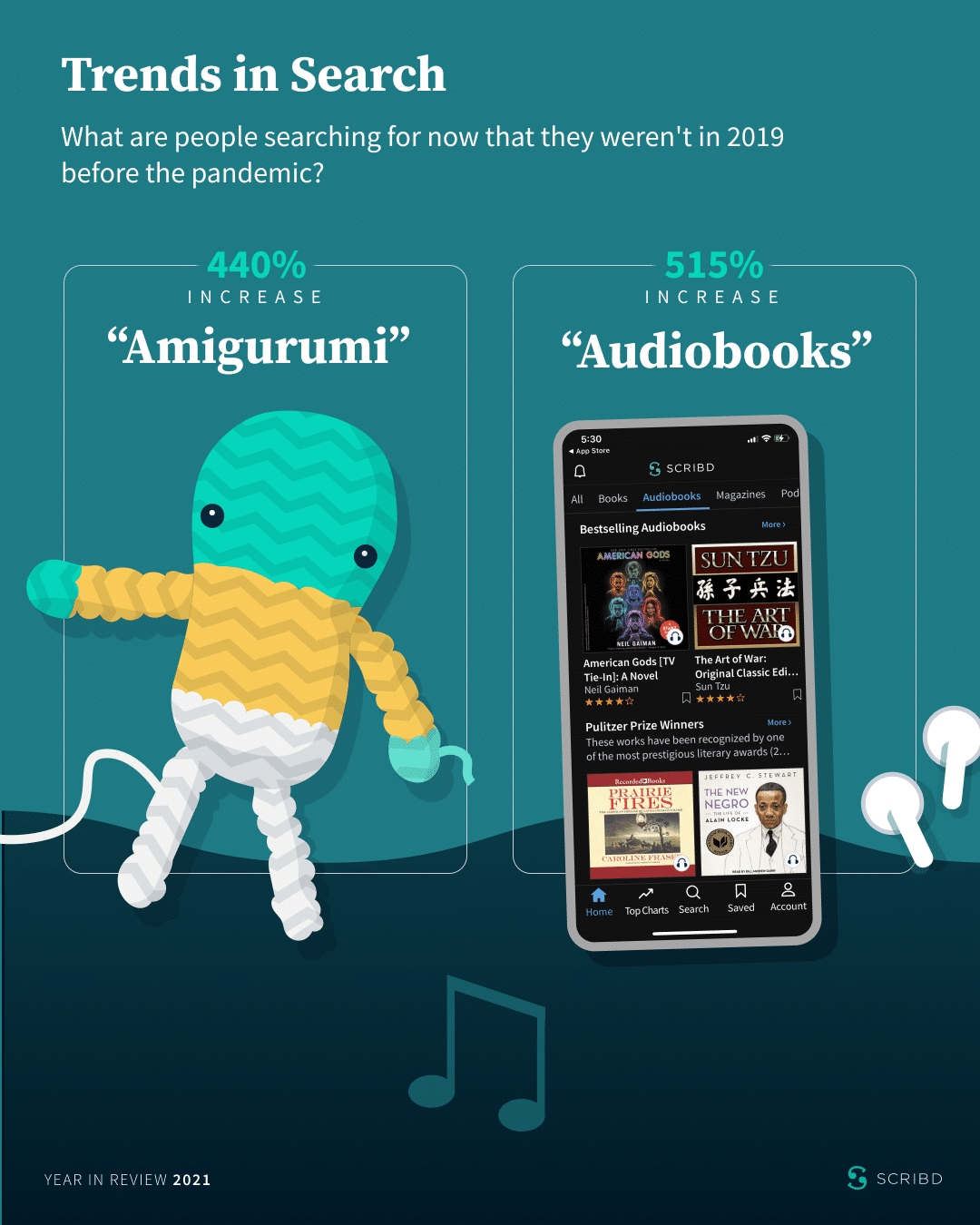
Searching for an audiobook is one thing, but people listened, too. In fact, the average Scribd user spent 42 hours listening to audiobooks so far in 2021. That’s 32% longer than in 2020 with 18% more readers starting an audiobook this year.
Fun Fact: Consistently top search terms were “piano” and “guitar,” which were always in the top 10 search terms from year to year. Whether it’s songbooks and sheet music or instructional books, it shows our users lean on culture and music in their free time.
What states are reading the most?
Based on total read time per person, here’s how people in each state are reading. Fun fact: Alaska ranked highest in ebook reading (even though it was 18th overall).

What genres are states reading?
These states lead the country in reading for each of the following categories:
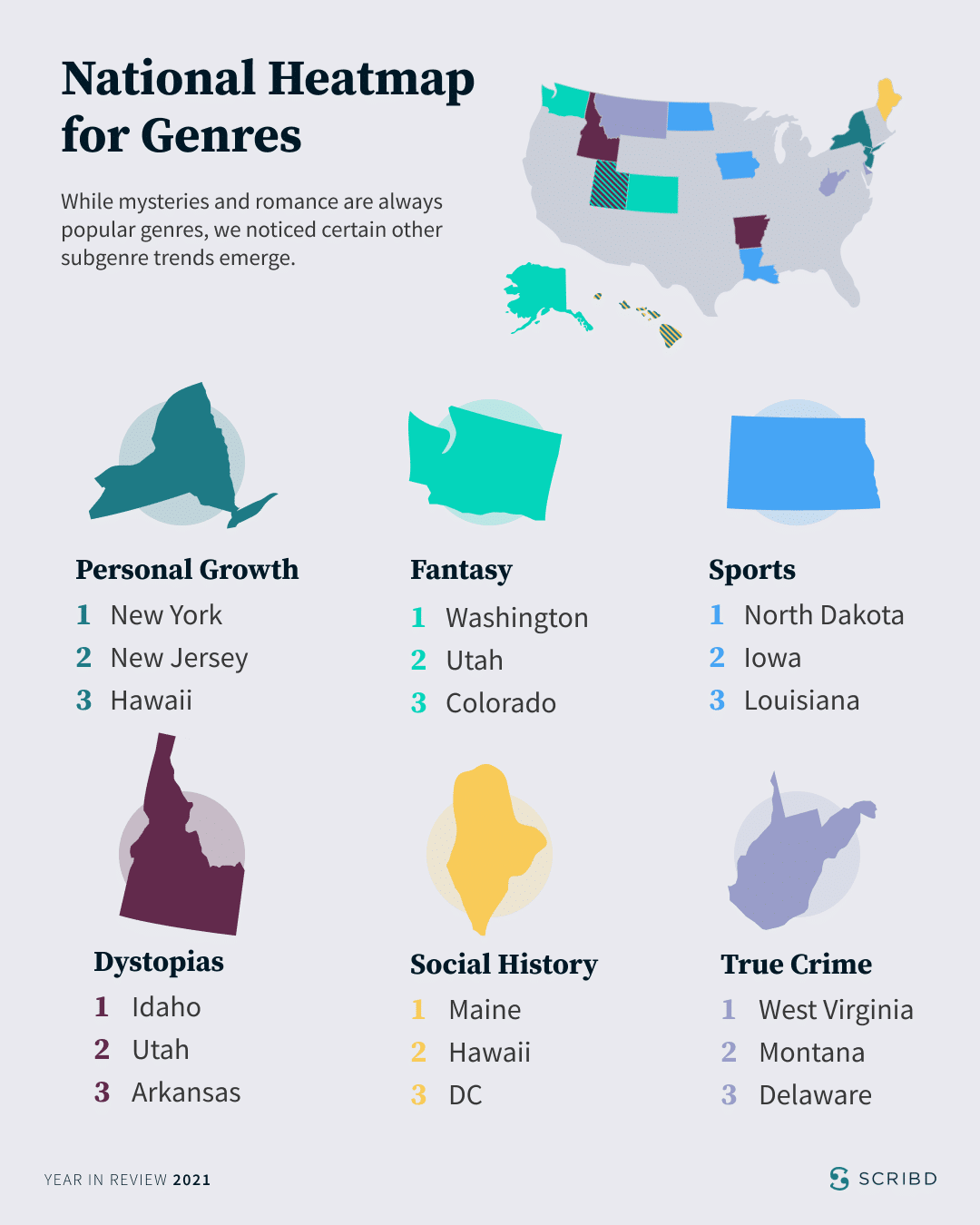
This report is based on proprietary data gathered and analyzed by Scribd’s strategy and analytics team, examining reading and user statistics from January through October 2021.
The statistics included are drawn from a sample set of more than 100 million hours consumed through our total marketplace of over 160M+ pieces of content and more than 800 million readers.
About the Author: Sarah Sung
Sarah is the Editorial Director at Scribd who obsesses over content strategy and brand building, and has written lifestyle content for AFAR, San Francisco Chronicle, and Under Armour. In her spare time she teaches indoor cycling and consumes podcasts, audiobooks, and ebooks at all times of the day and night. Traveling and dining out are always high on her to-do list
Key Takeaways
- Hardcover books are a direct descendant of the ancient codex. Because they are more durable and more expensive, they are considered more prestigious than paperback books. Traditionally, publishers order an initial print run in hardcover, followed by a paperback release.
- Paperback books are popular because they are more portable and less expensive than their hardcover equivalents are. Books issued in paperback can be either mass market paperbacks or trade paperbacks, which are pricier and higher quality. To stay competitive and to attract customers, publishers are releasing some novels simultaneously in hardcover and paperback; other books skip hardcover and are released as paperback originals.
- Although they make up only 3 to 5 percent of current sales, e-books have the potential to transform the book market. Gaining currency with customers only in recent years, the e-book has the advantage of being cheaper and more portable than even most paperbacks. Some concerns with e-books include the prevalence of piracy and the potential for digital decay.
Exercises
Create a list of the three book formats mentioned in this section, and then answer the following questions:
- What are the features, advantages, and drawbacks of each format?
- How do they differ? How are they the same?
- What type of person might each format appeal to?
- Which format do you prefer the most, and why?
References
Auletta, Ken. “Publish or Perish,” Annals of Communication, New Yorker, April 26, 2010.
Bollacker, Kurt D. “Avoiding a Digital Dark Age,” American Scientist 98, no. 3 (2010): 106.
Eco-Libris, “Some Facts About the Book Publishing Industry,” Eco-Libris, http://www.ecolibris.net/bookpublish.asp.
Frisch, Matt. “Digital Piracy Hits the E-book Industry,” CNN, January 1, 2010, http://www.cnn.com/2010/TECH/01/01/ebook.piracy/index.html.
McHugh, John B. “J. K. Rowling Refuses E-books for Potter,” USA Today, June 14, 2005, http://www.usatoday.com/life/books/news/2005-06-14-rowling-refuses-ebooks_x.htm.
Sung, Sarah. “Scribd Year in Review: Reading trends in 2021.” Scribd, Dec. 15, 2021, https://blog.scribd.com/scribd-year-in-review-reading-trends-in-2021/.
Ogle, “The Paperback Revolution.”
Wyatt, Edward. “Literary Novels Going Straight to Paperback,” New York Times, March 22, 2006, Books section.









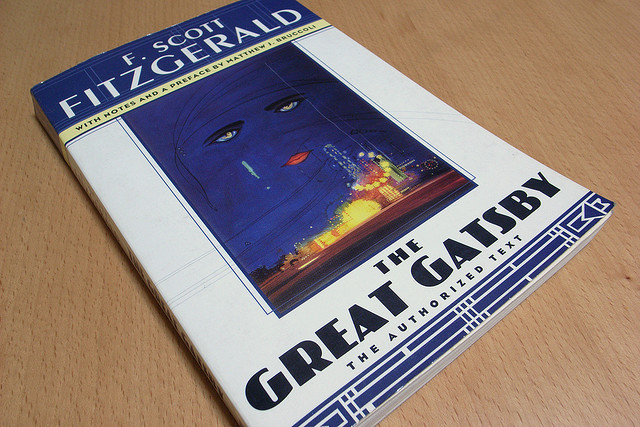

Feedback/Errata